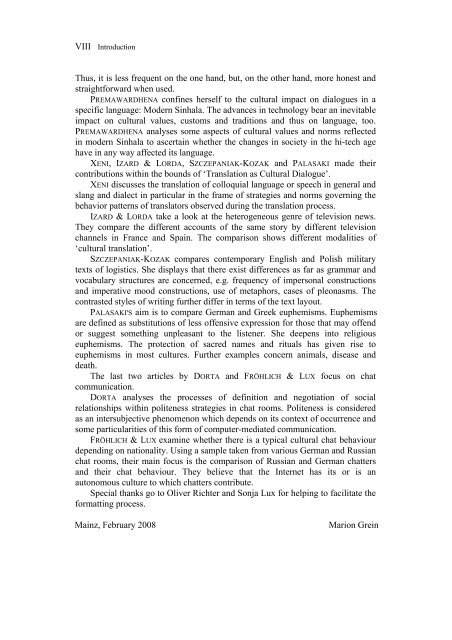Dialogue in and between Different Cultures - International ...
Dialogue in and between Different Cultures - International ...
Dialogue in and between Different Cultures - International ...
Create successful ePaper yourself
Turn your PDF publications into a flip-book with our unique Google optimized e-Paper software.
VIII Introduction<br />
Thus, it is less frequent on the one h<strong>and</strong>, but, on the other h<strong>and</strong>, more honest <strong>and</strong><br />
straightforward when used.<br />
PREMAWARDHENA conf<strong>in</strong>es herself to the cultural impact on dialogues <strong>in</strong> a<br />
specific language: Modern S<strong>in</strong>hala. The advances <strong>in</strong> technology bear an <strong>in</strong>evitable<br />
impact on cultural values, customs <strong>and</strong> traditions <strong>and</strong> thus on language, too.<br />
PREMAWARDHENA analyses some aspects of cultural values <strong>and</strong> norms reflected<br />
<strong>in</strong> modern S<strong>in</strong>hala to ascerta<strong>in</strong> whether the changes <strong>in</strong> society <strong>in</strong> the hi-tech age<br />
have <strong>in</strong> any way affected its language.<br />
XENI, IZARD & LORDA, SZCZEPANIAK-KOZAK <strong>and</strong> PALASAKI made their<br />
contributions with<strong>in</strong> the bounds of ‘Translation as Cultural <strong>Dialogue</strong>’.<br />
XENI discusses the translation of colloquial language or speech <strong>in</strong> general <strong>and</strong><br />
slang <strong>and</strong> dialect <strong>in</strong> particular <strong>in</strong> the frame of strategies <strong>and</strong> norms govern<strong>in</strong>g the<br />
behavior patterns of translators observed dur<strong>in</strong>g the translation process.<br />
IZARD & LORDA take a look at the heterogeneous genre of television news.<br />
They compare the different accounts of the same story by different television<br />
channels <strong>in</strong> France <strong>and</strong> Spa<strong>in</strong>. The comparison shows different modalities of<br />
‘cultural translation’.<br />
SZCZEPANIAK-KOZAK compares contemporary English <strong>and</strong> Polish military<br />
texts of logistics. She displays that there exist differences as far as grammar <strong>and</strong><br />
vocabulary structures are concerned, e.g. frequency of impersonal constructions<br />
<strong>and</strong> imperative mood constructions, use of metaphors, cases of pleonasms. The<br />
contrasted styles of writ<strong>in</strong>g further differ <strong>in</strong> terms of the text layout.<br />
PALASAKI'S aim is to compare German <strong>and</strong> Greek euphemisms. Euphemisms<br />
are def<strong>in</strong>ed as substitutions of less offensive expression for those that may offend<br />
or suggest someth<strong>in</strong>g unpleasant to the listener. She deepens <strong>in</strong>to religious<br />
euphemisms. The protection of sacred names <strong>and</strong> rituals has given rise to<br />
euphemisms <strong>in</strong> most cultures. Further examples concern animals, disease <strong>and</strong><br />
death.<br />
The last two articles by DORTA <strong>and</strong> FRÖHLICH & LUX focus on chat<br />
communication.<br />
DORTA analyses the processes of def<strong>in</strong>ition <strong>and</strong> negotiation of social<br />
relationships with<strong>in</strong> politeness strategies <strong>in</strong> chat rooms. Politeness is considered<br />
as an <strong>in</strong>tersubjective phenomenon which depends on its context of occurrence <strong>and</strong><br />
some particularities of this form of computer-mediated communication.<br />
FRÖHLICH & LUX exam<strong>in</strong>e whether there is a typical cultural chat behaviour<br />
depend<strong>in</strong>g on nationality. Us<strong>in</strong>g a sample taken from various German <strong>and</strong> Russian<br />
chat rooms, their ma<strong>in</strong> focus is the comparison of Russian <strong>and</strong> German chatters<br />
<strong>and</strong> their chat behaviour. They believe that the Internet has its or is an<br />
autonomous culture to which chatters contribute.<br />
Special thanks go to Oliver Richter <strong>and</strong> Sonja Lux for help<strong>in</strong>g to facilitate the<br />
formatt<strong>in</strong>g process.<br />
Ma<strong>in</strong>z, February 2008 Marion Gre<strong>in</strong>



